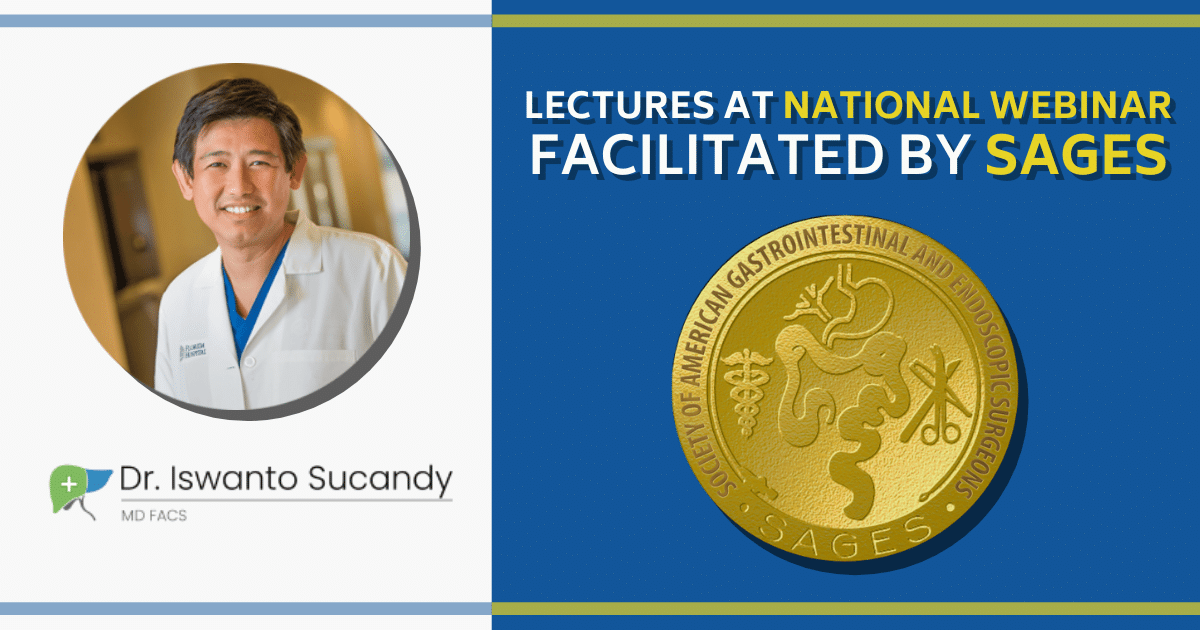Educating Others Through Invited Webinars Facilitated by SAGES
SAGES is a large national surgical association for gastrointestinal and endoscopic surgeons, which was founded in America in the late 1980s. One of its main goals is to advance education for surgeons and to improve outcomes for patients through minimally invasive surgical techniques. The organization now has more than 5000 active members both nationally and internationally. During the COVID-19 pandemic, the organization started an online initiative to host Webinars for surgeons. The webinars contained series of surgical lectures using Facebook social media platform revolving around commonly encountered surgical diseases and how to manage them. National experts in the field were invited to deliver these lectures, with goals to educate other colleagues.

Dr. Sucandy was invited to give two lectures via the online Webinars in April and May 2020. The 1st lecture was about diagnosis and management of bile duct injury following laparoscopic cholecystectomy. This is a particularly common problem for community general surgeons performing removal of gallbladder (cholecystectomy) for various indications such as acute cholecystitis, biliary dyskinesia, chronic cholecystitis, gallstones, gallbladder polyp, or gallbladder mass. Bile duct injury is a known potential major complication after laparoscopic cholecystectomy, which is often managed by a liver surgeon like Dr. Sucandy. In about 20% of bile duct injury, an associated vascular injury is also encountered. In this situation, time is of the essence to repair the associated vascular injury to decrease chance for bile duct ischemia. Dr. Sucandy and his colleagues discussed extensively all aspects of bile duct injury management, when to do the surgical repair, how to do it, who the best specialist to do it, and long-term outcomes of bile injury repair. The discussion was very educational for general and hepatobiliary surgeons. Dr. Sucandy is an experienced bile duct surgeon in Tampa Bay Area who treats bile duct disorders, ranging from bile duct injury, bile duct stricture, bile duct stones, gallbladder cancer, Klatskin tumor, and other bile duct cancer/malignancy.
The 2nd lecture given by Dr. Sucandy was about technique of robotic liver resection for liver tumors and biliary tumors, such as hepatocellular carcinoma, cholangiocarcinoma, colorectal cancer liver metastasis, gallbladder cancer, large premalignant hepatic adenoma, and neuroendocrine tumor liver metastasis. Minimally invasive liver surgery techniques have become popular worldwide as a better alternative to the traditional open liver resection. Together with other national experts from University of California San Francisco, City of Hope Cancer Center, Virginia Mason Medical Center in Seattle, and the Ohio state University, Dr. Sucandy shared his tips and tricks of how to do robotic liver surgery. How to avoid and manage bleeding during liver transection is one of the most important factor to achieve good outcomes in liver surgery. This had been a center of discussion and debate among surgeons in the last decade. In his lecture, Dr Sucandy discussed both minor and major liver resection technique, including robotic technique in biliary surgery. Again, the discussion was very useful and it was an eye opener for many surgeons from around the world.
Our team of liver surgeons led by Dr. Sucandy are regarded as national experts in their fields. We strive to help patients with liver and biliary tumors using the best and the most modern surgical methods. A consultation with a liver cancer doctor or liver specialist is necessary as the first step of treatment success.

